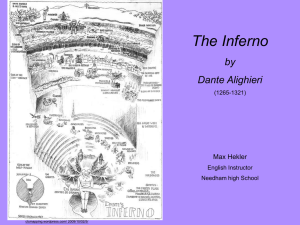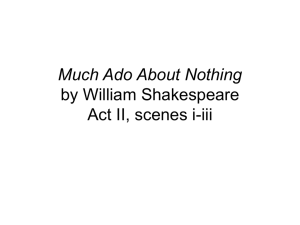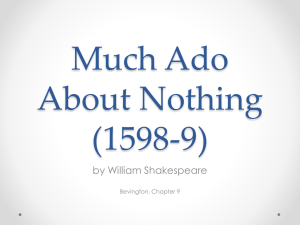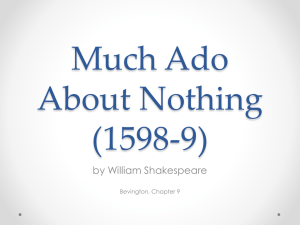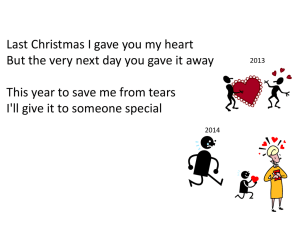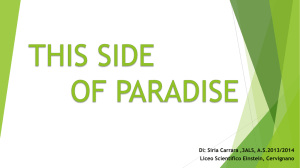The Eyes of Beatrice - IU School of Liberal Arts @ IUPUI
advertisement
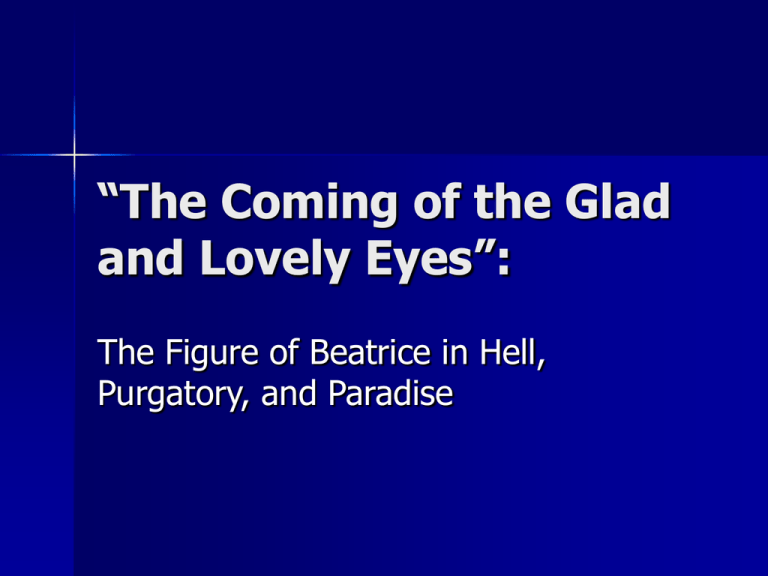
“The Coming of the Glad
and Lovely Eyes”:
The Figure of Beatrice in Hell,
Purgatory, and Paradise
Beatrice’s Eyes as a
Central Image
Constraints of time and space mean
that our final lecture will not focus on
the large-crowded canvas of Purgatory
and Paradise.
Instead we will follow a central motif:
the image of Beatrice’s eyes as it
functions in the Inferno, Purgatory,
and Paradise
Beatrice’s Eyes in Inferno
Canto II
In Canto II, Beatrice commissions Virgil to “rescue” Dante; her meeting is
filled with references to her eyes.
They are associated with the stars.
– They either “surpass” the splendor of the star’s” (ii.55: Longfellow,
Mendelbaum), or they are “kindled by the lamps of heaven” (Chiardi) (In
ascending order of symbolism, the stars are of a higher order than
Beatrice’s eyes).
– Nevertheless, they are associated with the stars—the stars which end
every Canto.
They are “star-gazing” eyes—“For I am Beatrice who, send you on/I come
from where I most long to return.” Later, in Canto xxxi of Paradiso, we will
learn that she longs to return to the place of beautic vision where she gazes
unceasingly at the light of God.
– We might also note that thus they are star-leading eyes. They don’t exist
to draw Dante to themselves—but to the “love that moves the sun and
the other stars.”
– Hence her love is different than greedy and lawless love of Paolo and
Francesca; it’s goal is the redemption and not “possession{“ of the loved
one.
Beatrice’s Eyes in Inferno
Canto II (Cont.)
–
–
They are love-filled and “love sent” eyes. She is gazing
upon Virgil because “Love sent me” (II. 73)
And because they are eyes of love, they are eyes of tears.
Note that the eyes “gleam” with tears. Tears increase, not
dim, their brightness. Notice the contrast here to the frozen
tears freeze in their eyes in Cocytus.
They tears clarify and focus. Virgil is eager “to hurry all the
more.” (ii. 116).
They are clear and brilliant eyes, like the clear and brilliant
stars which direct one out and up toward the highest—
toward even greater lights (like the Virgin’s eyes in
Paradise) and finally the full light of the beautific vision.
Beatrice’s Eyes are a clear contrast to the images of blindness and
unclear sight in hell.
Hell is a place which “closes its eyes” which has no place for the
bright, clear eyes of Beatrice or the starlight quality of their
gleaming.
It has ‘lost the good of the intellect” (III.20) the ultimate good is
the beatific vision—something which is seen with the eyes. To lose
the good of the intellect is to “go blind.”
But Most of all, Hell is a place of darkness and mist/ which can be
seen as a series of contrasts to Beatrice’s eyes.
–
–
At the end of canto IV they reach “a place where on light gleams”—
think of how Beatrice’s eyes gleamed with her tears.
At the beginning of that canto, hell is dark and deep and “filled with
mist.” Again, I am reminded of the contrast to the eyes of Beatrice
which become bright with her tears and increase the clarity and
resolution of those gazing into them
IV.The Tears of Beatrice and
the Grief of Satan
A Study of Contrasts
Beatrice’s tears motivate Virgil to hurry to Dante’s
rescue (ii.115-117)
Satan’s tears are an angry and sullen self torment
when express themselves in an angry devouring
of the sinners in his mouth
Her tears gleam brightly they are like the stars of
her eyes, bright and clean. His tears mingle with
bloody puss.
Her tears warm Virgil to action; His whole being
freezes people into self=pitting hating immobility.
Purgatory and the
Meeting with Beatrice
In the earthly paradise near the pinacle of Mt. Purgatory Virgil
speaks of Beatrice’s coming as the coming of her eyes
(Purgatory xxvii.135-142). Again her refers to their tears.
The”completing” and “redeeming” effect of Beatrice’s eyes
– Veiled like the sun’s face to be seen (xxx.25)
– They make Virgil Disappear. The coming of Beatrice’s eyes is the
signal for the disappearance of Virgil’s (xxx.49)
– The eyes that gleamed compassion to Virgil gleam sterness to
Dante.
Her eyes compel his to look into the stream and see himself in
shame. And her voice which was like an angel’s voice to
Virgil’s is “the voice of stern pity” here. (in jarring contrast to
the mocking jeering voices of sinners with each other).
The Disappearance of
Beatrice’s Eyes.
–
It is of the nature of the poem that Beatrice and her eyes
must disappear. Because Beatrice is not God, but a “God
bearing” image. Her goal in the poem is ultimately to draw
attention away from herself to that of the God whose
uncreated light all are to adore.
Thus, in Canto XXXI Dante, in a rapturous contemplation of
the Angels, like a swarm of celestial bees in eternal transit
between the celestial rose and God, turns around and finds
that Beatrice is gone—just as Virgil had disappeared earlier.
His last view of her eyes is as she sits among the blessed
forming a celestial rose.
She looks down and smiles, one last smile—but then, most
importantly she turns away from Dante and gazes at “the
Eternal Fountain”—as Dante is to do.
Eyes Giving Way to Stars
The Gesture of Beatrice is now repeated by another
pair of Eyes—The Virgin.
“The Eyes that God reveres” (xxxiii.40) are fixed
only briefly “on the suppliant” but “then her eyes
turned to the Eternal Light” (xxxiii.43)
So Again, the human eyes must give way to the
divine light for which they were formed.
So her eyes lead Dante’s eyes to contemplate the
vision of God: 3 circles of light upon one of which is
imprinted the “effigy” of a man.
And Then the sun which moves the sun and the
other stars.
